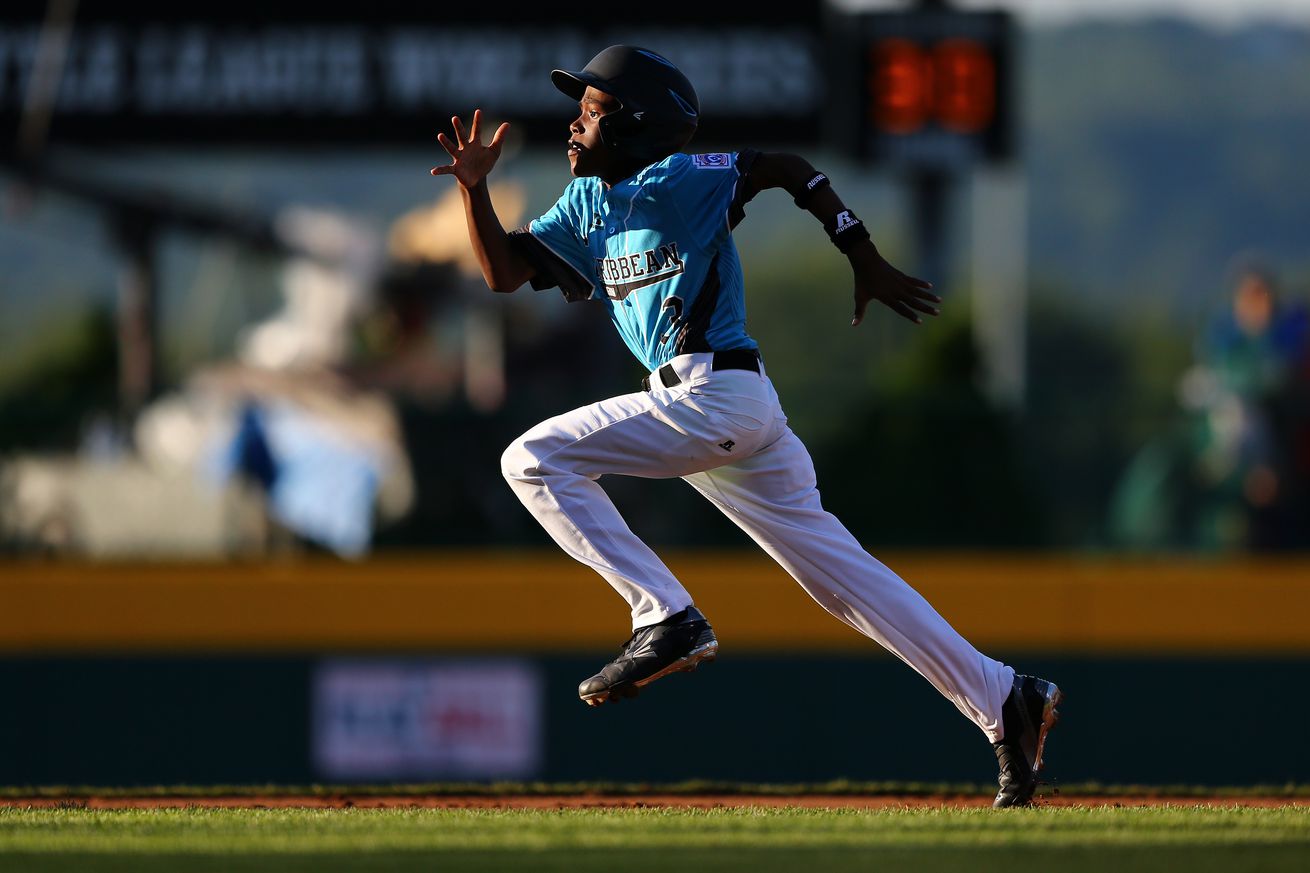
Plus, two winless clubs, and one of the best names in the system comes around.
The Week That Was
It was an odd week for full-season affiliates, who played split series: six games against the same teams, but switching ballparks between Thursday and Friday. It was a dismal week for Reno and Hillsboro, who were swept. Both are in last place, but the Hops (who led the league for most of the first half before collapsing) are already 11.5 games behind Eugene after playing just 15 games. Amarillo, on the other hand, won five of six and is tied for first place in the second half. Visalia split with Rancho Cucamonga and are also tied for first.
In the rookie leagues, the Pygmy Rattlers of Salt River went 2-3, the DSL Red squad went 4-1, and the DSL Black squad went 0-5. With the domestic complex league seasons starting to wind down, the Pygmy Rattlers are basically out of it, leaving the DSL Red squad (three games back in the DSL South) the lone rookie league side with postseason aspirations.
All in all, that’s a 14-25 week, which is dismal. The bats weren’t at fault, though; across the system, batters slashed .279/.364/.423 and plated 218 runs, or 5.59 per game. Unfortunately, the pitching posted a 5.72 ERA and the defense (with an assist from the zombies) added 35 unearned runs, as pitching allowed 244 to score. The WHIP+HBP for the week was 1.734.
But even though the overall results weren’t good, there were some great performances.
Batter of the Week
Jakey Josepha, Visalia (.389/.500/.778, 2 HR, 0.423 RC/PA)
Last year, Josepha (full name: Jakey Jair Isaiah Josepha) got a spot on the roster of prospects for the spring training showcase game. It made sense; he was rising up prospect lists, he had speed, he had an arm, he had decent pop for a teenager (he wouldn’t turn 20 until May) and he’d posted a .426 OBP in the complex in 2023.
But it didn’t go well. He barely hit the ball, didn’t hit it hard when he did hit the ball, and while his walks didn’t decrease much, his strikeout rate ballooned. He struck out in 42% of his plate appearances and posted a wRC+ of 3 before being sent back to the complex, where he continued to strike out in almost a third of his plate appearances and saw his wRC+ finish at 90, after it was 130 in 2023.
He cut the strikeouts in the complex this year, but still hadn’t shown much pop. He got promoted back to Visalia on June 3rd and it took him all of 10 games to equal his hit total from a month in Visalia last year. And he’s kept getting better, finally finding his power, including a 450 foot home run this week. His wRC+ since being promoted is 128. If he’d hit like this last year, he’d have found himself on all the prospect lists. Instead, he’s fallen off entirely.
Josepha remains a bit of a long shot; he’s filling out, though, and if he has very many more weeks like this one, he’ll find himself on prospect lists next year.
Honorable mention should go to the Amarillo group of Christian Cerda, Caleb Roberts, Kristian Robinson, and Ryan Waldschmidt, all of whom had big weeks to help Amarillo to their 5-1 record. And one would be remiss to leave out Tristin English, who posted a pair of three hit games and found himself in the big leagues.
Starting Pitchers of the Week
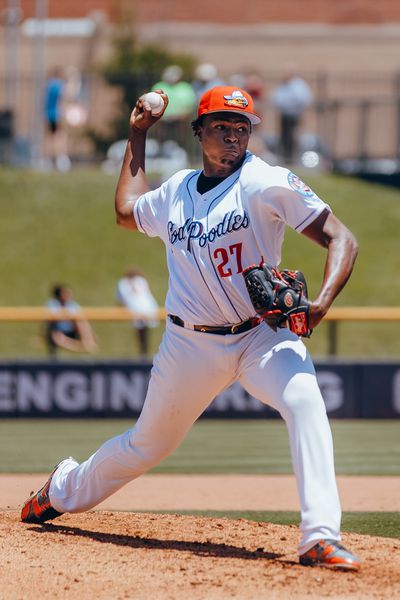
Photo by Elisa Chavez/Minor League Baseball via Getty Images
Jose Cabrera, Amarillo (2 GS, 10 IP, 4 H, 1 R, 6 K, 1.100 WHIP+HBP)
Cabrera saw his start on Tuesday cut short after four fantastic innings due to weather, and struggled a bit more on Sunday, but turned in a quality start and was excellent overall. He was still sitting at 94 with his fastball in the sixth inning, which is always a good sign.
Erick Reynoso, Visalia (6 IP, 1 H, 0 R, 3 BB, 8 K)
Reynoso didn’t get the win as his bullpen failed to hold it for him, but he did turn in a quality start and kept the Quakes off the board, which enabled the offense to come back and win it after the bullpen surrendered the lead. It was the second consecutive quality start for Reynoso; he took a hard-luck loss last week despite allowing just one run. Some run support would be nice.
Relief Pitcher of the Week
Hayden Durke, Amarillo (3 IP, 2 H, 1 unearned run, 1 BB, 5 K)
This could almost be renamed the “Hayden Durke Award” as he seems to be the most common recipient. It was another solid week in Amarillo, as he shows that he can master hitters in the Texas League just as he did in the Northwest League. How long will it be before he gets a shot in Reno?
Honorable mention must go to Jake Fitzgibbons, who extended his streak of scoreless appearances to 16 games, and his scoreless innings streak to 21.2 innings. He may not be as spectacular as Durke, but the results have been as good. He should get a shot in Hillsboro soon.
Diamondbacks Draft Success Under Hazen, Compared to Other Teams
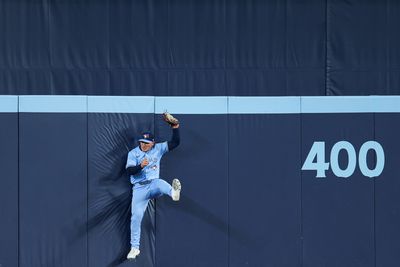
Photo by Michael Chisholm/MLB Photos via Getty Images
Four years is a reasonable time for players to advance through the minor league system. That means that there are now five drafts (one of which was the extremely truncated 2020 draft) we can look back on and make some sort of judgment. Obviously, players taken in those drafts who have not yet made it could still do so. Tristin English posted a wRC+ of 78 in Reno last year, which is entirely unacceptable for a corner player, but turned things around in a big way and found himself in Phoenix. Still, it’s instructive to see how the Diamondbacks did, compared to the rest of the league. Are fans justified in thinking (as all fans do, sometimes) that the team has underperformed?
First Round
The first round is the round where success is most likely. This has always been the case, but it might be becoming even more the case as scouting improves and teams’ modeling changes. Of course, there’s a big difference in draft success relative to position and level they were drafted from, but in this section, comparison is only to other teams from the same season.
Eight of the nine first round picks the Diamondbacks signed from 2017-2021 have made the major leagues. The only one who has not comes from the riskiest demographic: Brennan Malone, a high school pitcher. League-wide, 83% of first round draft picks from 2017 have made the big leagues, down to 58% in 2021. The only year where the Diamondbacks are not at 100% is 2019, where they’ve gotten three of four to the big leagues, against a league average of 78%. They’ve also gotten equivalent quality out of those players once they’ve reached the big leagues. While across the board, first round picks who have made the big leagues have been worth 2.3 bWAR for their careers on average, the Diamondbacks have averaged 2.18, and were it not for the ill-advised promotion of Jordan Lawlar earlier this season, would be above-average.
It must also be noted that Matt McLain is counted in those 2018 average numbers, but not in the Diamondbacks numbers. With that caveat, it’s safe to say that the Diamondbacks have been average or above-average with their first-round drafting.
Second Round
The Diamondbacks have had five second round picks reach the major leagues. That’s impressive enough, but they’ve also had a 100% success rate. They forfeited their second-round pick in 2020, so having fewer picks has something to do with it, but they’ve also been far more successful than the big leagues as a whole. The second round in 2017 has seen two-thirds of drafted players make the big leagues. Three seasons (2018, 2020, and 2021) have yet to get half of the second-round picks to the majors. Those who have made it have averaged 1.28 bWAR, while the five Diamondbacks have averaged 3.01 bWAR, more than double. Daulton Varsho has a lot to do with that, but the Diamondbacks have positive production from each season of second-round picks, with Drew Ellis the lone player to “miss” and given the rate of success in the draft, it’s hard to call any player who makes the big leagues a true miss. The Diamondbacks have had greater success in the second round than most teams.
Third Round
This section needed a re-write after yesterday’s events. For, while the Diamondbacks still haven’t done spectacular in the third round during Hazen’s tenure, Tristin English became the first of Hazen’s third-round picks to make it when his contract was selected from Reno yesterday. It’s been a long journey for English, who appeared to have stalled and has long since dropped off of top prospect lists, but he’s finally made it. 2022 was not included in these numbers, but Nate Savino could join him before long.
But it’s not like other teams have done well, either. Even when including English (although he is not yet officially a big leaguer) just 33% of third round picks from 2017-2021 have reached the major leagues. That’s well behind the second round and right in line with the third and fourth rounds. 2020 is the main culprit. So far, just two of the third round picks in the 2020 draft have reached the major leagues. The next earliest round to have so few draft picks reach the big leagues during that time span was the ninth round in 2021. (For the record, the only top-20 round from 2017-2021 not to produce a big leaguer is the 19th round in 2018. Just two players from that round remain in affiliated ball: Ian Villiers, who did not sign and was later drafted by the Giants, and Austin Schulfer, who is in AAA in the Phillies system.)
Fourth Round
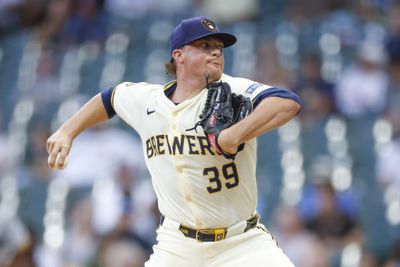
Photo by Brandon Sloter/Getty Images
The Diamondbacks have also been below-average in the fourth round, with just one of five picks to reach the big leagues. Again, though, that might change, with 2020 pick A.J. Vukovich and 2022 pick Dylan Ray both in AAA. That one big leaguer has been good, posting 1.3 bWAR against a league-wide average of 0.94. Unfortunately, that one big leaguer is Chad Patrick, and none of that value has come the Diamondbacks’ way thanks to an extremely ill-advised trade for Jace Peterson.
Fifth Round
The Diamondbacks have been above average in the fifth round when it comes to the number of big leaguers, with two of their five picks reaching the majors. But those two have been worse than the average of others, as they’ve averaged 0.2 bWAR against 0.92 bWAR. Brandon Pfaadt will hopefully improve the standing of fifth rounders, but Buddy Kennedy seems unlikely to contribute further.
Sixth-Tenth Rounds
In this set of rounds, the Diamondbacks have seen 20% of drafted players reach the big leagues. That’s right in line with league average. bWAR average league-wide is 1.04, while players drafted by the Diamondbacks have averaged 2.44 bWAR. That’s really good production, but unfortunately José Caballero accounts for almost half of it, and he was traded for Mike Leake early in his professional career. Almost all of the rest of it comes from Tyler Holton, who was released and has found most of his success in Detroit. Add Dominic Canzone to the list of players who have provided most of their value elsewhere. Only Andrew Saalfrank remains to boost what the Diamondbacks have gotten from this set of picks.
Eleventh-Twentieth (and beyond) Rounds
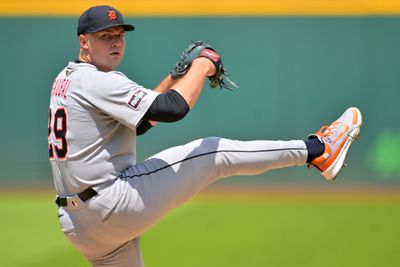
Photo by Jason Miller/Getty Images
Out of fifty picks (not all of whom signed, of course) the Diamondbacks have produced two big leaguers. Across the board, 12% of players reached the big leagues. The two who have made it (Blaze Alexander and Tim Tawa) have both provided useful production. However, both were eleventh round picks. Under Hazen, no one picked later than the eleventh round and signed has made the big leagues, with the exception of Matt Peacock, a 23rd round pick. It’s important to note that the 12% figure includes players who did not sign, were drafted again later, and did sign. For example, Tarik Skubal, who was drafted by the Diamondbacks (29th round) but did not sign, and was a ninth-round pick of the Tigers the following year.
Risk Factor
One reason for the lack of success the Diamondbacks have found in the third round is that they’ve taken risky players there. More than half of the total players selected in the third round 2017-2021 were college players; the Diamondbacks selected pitchers with four of the picks, three of whom were from high school. High school pitchers are the least likely demographic to make it, and Matt Tabor was from Massachusetts (a non-traditional area) while Jacob Steinmetz was always going to have an interesting journey to make it (and might still do so). Since 2021, the third round has seen college players taken each year, two of whom are performing well in the minors.
One tendency that the Diamondbacks have had under Hazen is taking high-upside, risky guys in the third through fifth rounds. In 2017, each of those picks was used on a high school player, two of whom were pitchers and two of whom were from non-traditional areas. Buddy Kennedy made it, but the pitchers both washed out. In 2018, each pick was used on a college pitcher. 2019 was a more conservative year, with the pick of English, but there were also the picks of GJ Hill and Conor Grammes. Hill is in the Rockies’ system and has finally reached AA, while Grammes is a borderline reliever piece. Norris, Vukovich, and Pfaadt all carried a sizeable amount of risk in 2020 for a variety of reasons. Caleb Roberts in 2021 was another safe-ish pick but it hasn’t come off, as he’s stalled at AA, although it must be noted that Tristin English appeared to have stalled for a while. In more recent years, picks like Dylan Ray, Tytus Cissell, and Connor Foley underscore that these picks are most often used on guys with a definite tool and the hope to grow into more.
Every team does this, but they do it at different spots. The Rays may have gotten a little more production from these spots, but they’ve also not taken a high school player from north of Georgia in one of those rounds since 2016. And still, even with every fourth round pick they made from 2017-2021 being a college player, three of them being position players from baseball-friendly locations, they haven’t found a big leaguer.
Pitchers
One consistent complaint is that the organization struggles to find and develop pitchers. There are multiple factors to this, of course, but the draft is certainly one of them. But have the Diamondbacks done worse than other teams? Baseball America published a piece after the 2023 draft that helpfully breaks down the success rate of picks in the first two rounds by category. Rather than simply making it, these percentages are for making a single start in the big leagues.
· College RHP 1st round: 71.4%
· College RHP 2nd round: 50.3%
· College LHP 1st round: 72.2%
· College LHP 2nd round: 50.6%
· High School RHP 1st round: 73.2%
· High School RHP 2nd round: 42%
· High School LHP 1st round: 59.2%
· High School LHP 2nd round: 60.3%
From 2017-2021, the Diamondbacks drafted seven pitchers in the first two rounds. Six have made the major leagues, and all of them have at least one start. That’s 85.7%, well above-average. High-school lefty Blake Walston has made it despite being from the riskiest demographic. The only pitcher not to make it is Brennan Malone, who is still in the Pirates’ system. But while he’s listed as a first-rounder, keep in mind that he was the 33rd pick, making him closer to a second-round pick, where the success rate is only 42%. If we treat picks 31 and later as second-round picks, Slade Cecconi, Drey Jameson, and Malone move from the expected range of 70% making it to a coin flip. That gives the Diamondbacks basically six “coin-flip” pitchers, as the only true first rounders were Walston and Bryce Jarvis, and Walston is already in the 59.2% demographic. Five of six making it is a really good rate.
But most pitchers drafted have had very short careers. With the exception of high-school left-handed pitchers, none of these demographics sees more than 29.6% make 25 starts. While Blake Walston has made just two starts, Tommy Henry, Ryne Nelson, and Slade Cecconi have all exceeded 25 major league starts. That’s 42.9%, above league average.
Chad Patrick and Brandon Pfaadt are two pitchers the Diamondbacks selected in later rounds who are producing. Pfaadt has already exceeded 25 starts, and Patrick is at 18.
Another way to compare success is to look at how pitchers taken in the same rounds from the same level have fared. There have been 254 pitchers selected in the same rounds as the Diamondbacks selected a pitcher, from the same demographic. I’m counting the one who made it as a position player (Dane Myers) as half a pitcher, which gives basically one-third of pitchers making it (33.268%). The Diamondbacks have selected 28 pitchers in those rounds and seen eleven reach the major leagues, or 39.3%.
Conclusion
While fans obviously would like Hazen’s front office to have found more stars in the draft, this doesn’t mean that his front offices have drafted poorly, relative to the league. There have been misses. There have been hits. It’s possible to complain that Hazen doesn’t take enough pitchers early, and takes risky pitchers. But even those risky pitchers pan out at slightly above the league average. Hazen’s front offices have drafted well at the rounds where the return on investment is most expected. They’ve drafted fairly well through the first 11 rounds; not finding a single major leaguer in rounds 12-20 is kind of disappointing, but those rounds are always a bit of a crapshoot, and that run of futility could well end later this year, with Austin Pope in AAA.
2025 MLB Draft Preview
Entering the 2025 draft, things seem as wide-open as at any point in recent years. Not only is there no real consensus as to who the Diamondbacks will take with their first-round pick, there’s no real consensus as to who should be drafted first overall, although it seems to be down to LSU pitcher Kade Anderson and high school shortstop Ethan Holliday. There is a set of 6-10 names who are almost certain to be gone before the Diamondbacks pick. That’s about all that can be stated with certainty.
However, the fact that little is certain has not stopped pundits from stereotyping picks to the Diamondbacks. They really can’t help themselves. Yes, the Diamondbacks have taken (and had great success with) shorter players. But the Diamondbacks have also taken plenty of players who have more prototypical size, particularly in the early rounds.
Another area that doesn’t get quite as much attention is that the Diamondbacks have drafted players from outside of the traditional locales. While Mike Hazen wasn’t here when the Diamondbacks passed on Mike Trout (twice) partially because they thought Bobby Borchering was a safer bet given that he’d faced tougher competition in high school, the fact that a bunch of teams passed on arguably the greatest player of a generation surely is not lost on him. He’s drafted plenty of players from non-traditional places, although generally not high. Daulton Varsho is the greatest success (to sign), but JD Dix is progressing as well as could be expected and Drey Jameson has made the big leagues. A.J. Vukovich is another high school draftee from Wisconsin and while he’s struggling right now, he was a high school pick in the COVID draft and is in AAA. Avery Short was a high school pick from Indiana who appeared at AAA this year, Austin Pope was drafted from Fairfield University in Connecticut (which has produced just two MLB players, and none that have appeared since 1983), Buddy Kennedy was both short and from a non-traditional location and reached the major leagues, and Hazen’s front office also drafted a pitcher from a small school with exactly one NCAA tournament appearance (in 1954). Unfortunately, Tarik Skubal elected to return to school and the pick was not repeated in 2018, but the decision to draft Skubal was clearly the right one.
The Diamondbacks have also drafted players who found their stock falling after difficult seasons. Adrian Del Castillo looked like a first rounder going into the 2021 season, but dropped after a poor offensive showing.
That’s been a whole lot of words to say that no one really knows what will happen. But that doesn’t stop people (including me) from guessing at it. Here are some of my thoughts on what will happen. I’ll grade my predictions as a 50 (on the 20-80 scale) with a high bust probability.
1. Don’t expect a pitcher at #18
Since Hazen took over, the Diamondbacks have selected a pitcher as high as 18 once, when they drafted Jarvis in the COVID draft at #18. Out of the top-100 picks since Hazen came onboard, just 14 have been used for pitchers. While that sounds like a decent number, that’s 40% when 50% of your roster is pitchers. And eight of those are concentrated in the 2019-2020 drafts. Since 2020, Hazen has used just four of his 16 top-100 draft picks on pitchers.
In addition, the top pitchers are almost all going to be off the board. While it’s possible that Gage Wood falls to the Diamondbacks at 18, he’s a high risk for health-related reasons and he’s pitched extra with his stint in the College World Series, so I don’t expect Hazen to take him, unless he were to fall all the way to 29. Tyler Bremner has less health risk, but is a high risk to return to school and try to work his way back to being in consideration for the top overall pick. If he’s drafted at #18, he’ll be looking for top-ten money.
2. Position doesn’t matter
This is true for every team, but skips past the mind of fans. There are also two meanings to it.
First, baseball teams do not draft according to perceived need, unless as a tiebreaker between two players they rate the same. They are going to take the top player available on their board.
Second, the position that is announced on draft day can be virtually meaningless. From 2020 on, the Diamondbacks have drafted five players who were announced as third baseman. Only LuJames Groover is routinely playing the position, while A.J. Vukovich and Gavin Conticello are playing center field.
Practically every position player taken (apart from catchers) will have played either shortstop or center field in high school. Even a fair number of pitchers will have played shortstop on days they weren’t pitching.
3. High floor bats early, high ceiling pitching after
This has been the pattern in recent years. Last year saw a number of pitchers drafted, some of whom have top of the rotation ceilings, but all of whom come with a decent chance of busting entirely. Expect this pattern to continue, because there will still be plenty of high floor bats available at 18 and 29, but by the time it gets to pick #92 it’s going to be high ceiling guys until you get into the run on college seniors that always comes in later rounds. One exception to this is if there is a high ceiling bat available that the Diamondbacks love. There will likely be one that I would like to see selected, but indications are that the Diamondbacks don’t feel the same way.
4. Don’t expect to cut a deal
While the Diamondbacks might be able to save a few hundred thousand on their first two picks, cutting a deal should not be a big part of the plan. They don’t have the large bonus pool they’ve had in the past; only two of their picks have a slot value over $1 million. And with the chasm fixed between their second and third picks, it’ll be hard to count on a player you like enough to go over slot being available at 92. In fact, if the Diamondbacks go over slot, it might well be on the first two picks, if a player who might choose to go to college (or return to college) is available to them.
5. Don’t expect to see high draft picks play right away, even in the minors
This should go without saying, given that Slade Caldwell didn’t make his debut until this year. But any pitcher selected is going to be held out until next year for load management reasons, and after injuries befell the top pick in the draft in consecutive seasons (Jordan Lawlar in a game, Druw Jones in batting practice) it makes sense that the Diamondbacks would be cautious. Besides, the complex season will be over by the time the picks sign, so playing this year would be limited to players the team is willing to start in Visalia. That’ll be bats from major colleges.
Who I would like to see taken on the first day
This is a wish list of players who are likely to be available. So you won’t find a probable top-ten player on here. My rankings also probably bear little resemblance to how the Diamondbacks rank players. I also have no real information on whether these players would want to sign with Arizona, or what their bonus demands would be. With all those caveats, I present the players I’d select, and remind you that Ian Rebhan, Chris Slivka and Mike Hazen are paid to get and develop the right players, and no one pays for my opinions, so that tells you how valuable they are.
#18: Jace LaViolette, OF, Texas A&M
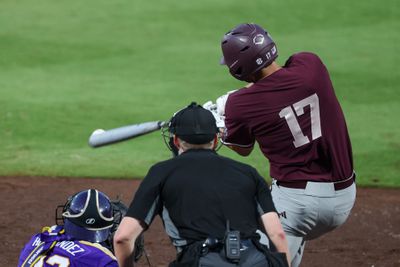
Photo by David Buono/Icon Sportswire via Getty Images
In February, anyone raising the notion of the Diamondbacks having the chance to select LaViolette would have been laughed out of town. The big Texan had hit fifty home runs across his first two seasons in College Station, and also drawn 112 walks. Sure, he was striking out a lot, but a 6’6” strong-armed outfielder with 70 grade power? If he’d just sustained his production, he could have been the top pick. But while he still drew walks, his power and batting average both dropped. His slugging percentage dropped 150 points. Now he’s being projected in the early 20s. Given that there might be a difference of 300-800K between the Diamondbacks and where LaViolette is currently projected to be taken, he’d probably sign a slot value deal.
Whoever does wind up drafting LaViolette will get one of the most powerful bats in the draft, someone who could be a legitimate 40 home run threat. They’ll also be getting a fair bit of swing and miss. There would be decent bust potential, but the ceiling is a player who was once expected to go first overall. Whoever is drafting him should also keep in mind that Texas A&M had a dismal year as a group, as they went through their coach bolting to their arch-rival. They went from the preseason #1 team to failing to make the tournament. Some percentage of LaViolette’s struggles should be ascribed to the circumstances. Assuming that he is, in fact, available at #18, he should be the pick.
Of course, that’s my opinion, and I’m higher on college guys simply because I see a lot more of them. And the Diamondbacks tend to value contact highly, even in high-power guys. But LaViolette is an interesting case, given that he’s consistently drawn walks. The Diamondbacks value knowledge of the strike zone and drawing walks.
#29: Caden Bodine, C, Coastal Carolina
Bodine is being mocked to the Diamondbacks by at least one site. He’s the best all-around catcher in the draft. His contact skill is among the best college hitters, but he lacks power, making him almost the polar opposite of LaViolette. But unlike LaViolette, he projects to stick at a premium defensive position. You can’t have too many catchers. Ike Irish was once considered to be an option here or at #18, but he’s now projected to go above that spot, with some drawing comparisons to Cal Raleigh.
#92: Malachi Witherspoon, RHP, Oklahoma
If the name sounds familiar, it’s because the Diamondbacks have already drafted Witherspoon once, in 2022. He was a twelfth round selection and unsurprisingly, they were unable to sign him. He’s the lesser-regarded of the twin Witherspoons, with Kyson expected to go in the first round. There’s substantial reliever risk, but his floor (assuming health, of course) is a fireballer out of the bullpen. Any pitcher taken later who has top of the rotation potential will come with more risk.
Some names for later rounds
I’d love to see the Diamondbacks get some players like Taitn Gray, Reid Worley, Brett Crossland, Jalin Flores, Judd Utermark, Dominick Reid, Mason Estrada, and Pico Kohn. Gray probably winds up going to college unless he gets offered a ton, though, so unless the Diamondbacks are able to get some solid savings at 18 and 29, he’ll certainly be outside of the price range. Worley is another high school player who might make more money in the long run by going the college route. Crossland is from Phoenix and it’s always good to have local guys, but he’s also extremely talented and has some college risk. Flores looks like he could stick at shortstop and has seen his stock drop due to poor offensive numbers, but his BABIP also dropped from .372 to .257, and that accounted for most of the drop in production, although his power numbers also declined slightly. Utermark is a powerful hitter who might be able to stick at third base, but is probably eventually ticketed for first base. He also comes with high strikeout numbers, so there’s a fair amount of risk, but that’s find for a pick after the fifth round. Reid and Estrada are both small college pitchers who have great pitch metrics. Estrada has the added bonus of being smart enough to get into MIT. Finally, Pico Kohn is a lefty starter at Mississippi State who put up big strikeout numbers since missing the 2023 season due to Tommy John, and bears resemblance to other pitchers the Diamondbacks have helped reach success, most notably Spencer Giesting. The fact that, in the age of (legal) money being paid to college players, he’s continued to drive the same Toyota SUV which is about a decade old speaks to his having some good sense. Besides, the more Mississippi State players are in the system, the more my wife is fine with me watching minor league baseball.
